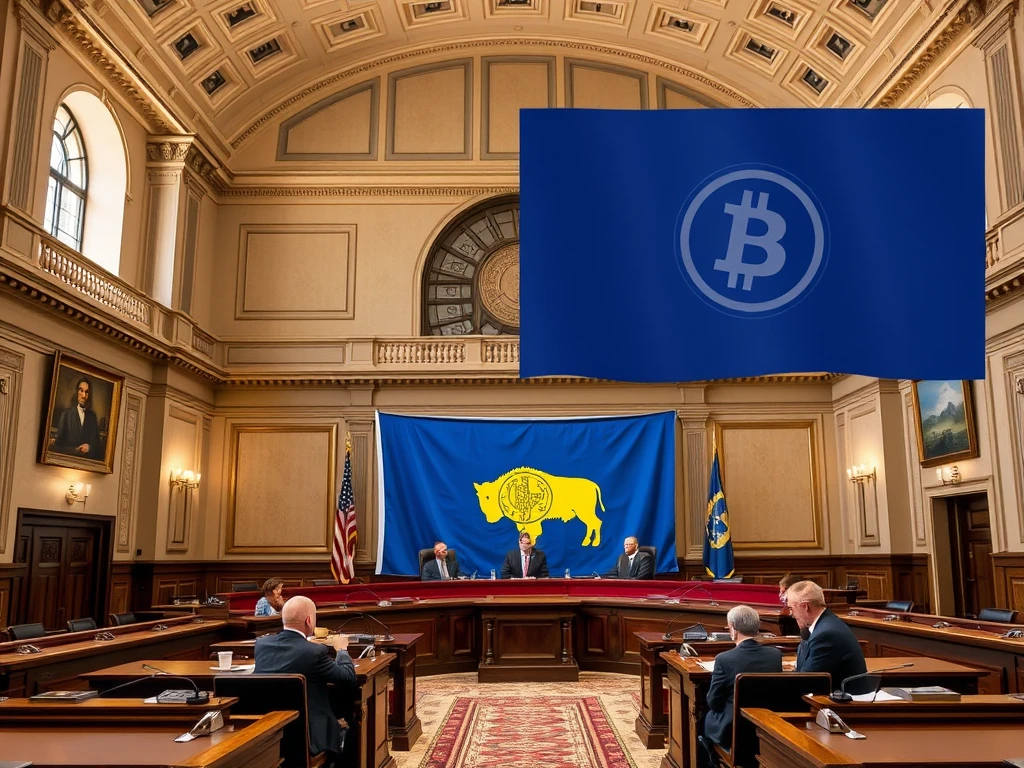Wyoming’s Stablecoin Dilemma: Decoding SEC Crypto Regulation

The winds of crypto regulation are swirling, and even states known for their digital asset friendliness are feeling the draft. Wyoming, a state that has long championed the crypto industry, is now grappling with a critical question: Will its state-issued stablecoin, WYST, fall under the watchful eye of the Securities and Exchange Commission (SEC)? This query has sparked discussions within the Wyoming Stable Token Commission, highlighting the ongoing uncertainty surrounding stablecoin regulation in the United States.
Decoding SEC Rules for Stablecoins: What’s the Fuss About?
In April, the SEC issued guidelines that sought to define “covered stablecoins.” This move sent ripples through the crypto world, prompting the Wyoming Stable Token Commission to re-evaluate its approach to WYST. Commissioner Joel Revill suggested the commission might need to refine its language to minimize the risk of WYST being classified as a security under SEC rules. But what exactly are these rules, and why are they causing such a stir?
- Clarity on “Covered Stablecoins”: The SEC guidelines aim to clarify which stablecoins might be subject to securities regulations. This definition is crucial because it determines the reporting and compliance burdens for stablecoin issuers.
- Security vs. Non-Security: The core question is whether a stablecoin is deemed a security or not. Securities are subject to stricter regulations, including registration requirements and ongoing reporting. Non-securities face a lighter regulatory touch.
- Wyoming’s Concern: The Wyoming commission wants to ensure WYST is structured in a way that avoids triggering security classifications under the SEC’s framework, ensuring smoother operations and wider adoption.
Executive Director Anthony Apollo emphasized the need to develop their own “vernacular” to navigate these regulatory waters. This internal deliberation underscores the complexity of fitting state-level crypto initiatives within the broader federal regulatory landscape.
The Wyoming Stablecoin (WYST) Project: A State’s Ambitious Crypto Venture
Wyoming’s foray into the world of stablecoins is not just a theoretical exercise. The state has authorized the creation of WYST, a stablecoin pegged to the US dollar and redeemable for fiat currency. This initiative is part of Wyoming’s broader strategy to become a hub for digital asset innovation. Why is Wyoming so keen on launching its own Wyoming stablecoin?
- Innovation Hub Ambition: Wyoming aims to attract crypto businesses and talent by creating a regulatory-friendly environment. WYST is a key component of this strategy.
- Financial Autonomy: A state-issued stablecoin could potentially offer greater financial autonomy and efficiency within Wyoming’s economy.
- Blockchain Integration: Wyoming is exploring integrating blockchain technology into various aspects of its governance and financial systems, with WYST as a foundational element.
Initially slated for a Q1 2025 launch, the timeline for WYST has been adjusted to potentially July 2025. This slight delay likely reflects the commission’s careful navigation of the evolving crypto regulation landscape.
Looking to Washington: Federal Guidance on Stablecoins
The Wyoming commission isn’t operating in a vacuum. They are keenly watching developments in Washington D.C., where federal lawmakers are considering legislation to establish a national regulatory framework for stablecoins. Key bills under consideration include:
- GENIUS Act: The Guiding and Establishing National Innovation for US Stablecoins Act in the Senate.
- STABLE Act: The Stablecoin Transparency and Accountability for a Better Ledger Economy Act in the House of Representatives.
These legislative efforts signal a growing recognition at the federal level of the importance of stablecoin regulation. The outcome of these bills could significantly impact Wyoming’s WYST project and the broader stablecoin industry.
Wyoming’s Crypto-Friendly Stance: A Double-Edged Sword?
Wyoming’s proactive approach to crypto has attracted companies like Custodia Bank, founded by Caitlin Long. Senator Cynthia Lummis, representing Wyoming, is a vocal advocate for crypto-friendly policies. However, this welcoming stance also places Wyoming in the spotlight as federal regulators like the SEC become more active in the crypto space.
Is Wyoming’s crypto-friendly reputation a boon or a potential challenge in the face of increasing regulatory scrutiny? It’s likely both. The state’s proactive approach positions it as a leader in crypto innovation, but it also necessitates careful navigation of complex and evolving regulations. The Wyoming Stable Token Commission’s current deliberations are a prime example of this balancing act.
The Road Ahead for WYST and Stablecoin Regulation
The Wyoming Stable Token Commission’s discussions are a microcosm of the broader challenges facing the stablecoin industry. As regulators worldwide grapple with how to oversee these digital assets, clarity and consistency are paramount. Wyoming’s efforts to preemptively address potential SEC concerns demonstrate a forward-thinking approach. The coming months will be crucial as both federal legislation and state-level initiatives like WYST continue to evolve.
Will Wyoming successfully launch its state stablecoin while staying compliant with federal guidelines? The answer remains to be seen, but one thing is clear: Wyoming is determined to remain at the forefront of crypto innovation, even as the regulatory landscape becomes more defined.
Conclusion: Navigating the Crypto Regulatory Maze
The Wyoming Stable Token Commission’s exploration of SEC rules and their potential impact on WYST highlights the intricate dance between innovation and regulation in the crypto world. As the industry matures, proactive engagement with regulatory bodies and a willingness to adapt will be essential for success. Wyoming’s journey with its stablecoin project serves as a valuable case study for other states and crypto enterprises navigating the evolving landscape of digital asset regulation. The future of Wyoming stablecoin and the broader stablecoin regulation framework remains a developing story, one that the crypto world is watching with keen interest.







